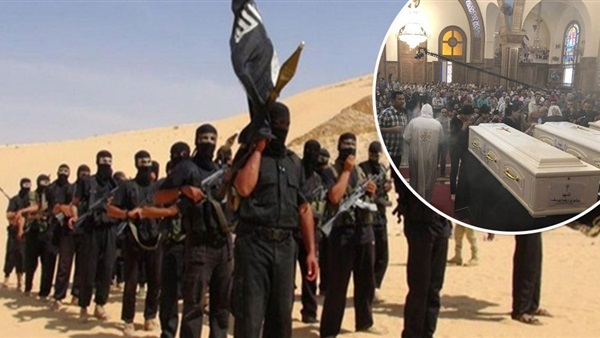ISIS’ targeting of Copts in Minya will not revive the organization

It is striking that the declaration of ISIS usually comes
quickly in the days between committing an attack and adopting it, and sometimes
the attack remains without a clear adoption of its commission, such as with the
attack against the Rawda Mosque in the city of Bir al-Abed in northern Sinai,
which was committed in November last year and left more than 300 people dead.
The speed of adopting the attack is entirely consistent with
the general view, where the organization's attempt to "prove its
existence" on the eve of the World Youth Forum in Sharm el-Sheikh. The
forum brings together young people of different nationalities, serving as an
additional indicator of the recovery of the Egyptian security situation.
However, the terrorist organization tried to counter this by demonstrating that
it still exists and is capable of launching operations against the Copts and
those included in its concept of the "close enemy", which in the
Egyptian case includes "the regime, its organs and the Christians."
Geographic range
The execution of the operation in the desert hinterland of
Upper Egypt’s Minya governorate indicates the involvement of remnants of the ISIS
of Upper Egypt group, which is led by the fugitive terrorist Amr Saad Abbas. This
reflects the ability of these small groups, which are likely concentrated in
the mountain paths, to launch more attacks. However, it is a limited ability
linked to elements loose in rugged areas who are easy to catch.
This limited ability was overshadowed by the organization’s
failure to storm the Mar Mina Church in Helwan in December 2017, where the
security forces and citizens were able to paralyze the attacker. This was the
last known attack that ISIS of Upper Egypt attempted to carry out before Friday's
operation. This means that this group needed 10 months to carry out an attack,
an additional indicator of a decline in its physical and mobile capabilities.
On the other hand, the geographical scope of Friday's attack
is given another dimension, where the first organization in Sinai was
neutralized from the theaters of operations, reflecting the great security
success in undermining the organization's capabilities and destroying its
infrastructure in Sinai as a result of the Comprehensive Operation Sinai 2018
that was launched on February 9.
The last operation attempted by the organization in Sinai was
on February 23, two weeks after the launch of Comprehensive Operation Sinai
2018. The attack targeted the headquarters of 101st Battalion of the
Border Guard Corps, but the armed forces were able to thwart the attack and
kill four of the organization’s members.
Targets
Tracking the organization's operations in 2017 and 2018
reveals the priority of soft targets versus the decline of military targets. A
soft target is one that is easy to target, such as the bus of Copts on Friday
and the worshipers at the Rawda Mosque in Bir al-Abed before, along with the
civilians in Sinai in general due to their collaboration with security forces.
The focus on soft targets reflects a decline in tactical and
physical capabilities, where targeting them would not need more than tracking
targets, setting the zero hour, quickly escaping after the attack, providing a
safe hiding place, and laying low for a period to avoid security after attacks.
In contrast, a military target of the army or police, whether mobile or stationary,
increases the organization’s margin of loss, whether any attack succeeded or was
completely thwarted.
The terrorist organization’s human elements have decreased
due the army and police forces arresting and killing dozens of them weekly, and
its material resources have also declined with the destruction of a large part
of the its infrastructure in Sinai and the tightening of security measures at
all land and sea border crossings, especially with the Gaza Strip. All these
factors have forced the organization to focus on soft targets.
Time range of the organization’s operations
The time ranges of the organization’s operations have diverged
remarkably, as with the "seasons of attacks" during which it
typically launched attacks, such as during religious seasons like Ramadan and
the first ten days of Dhul Hijjah or national seasons like the 6th
of October Victory celebration, Sinai Liberation Day, and the anniversaries of
the January and June revolutions, and so on. This is an indication of the
nature of the phase that the organization seeks to revive, in which there are
semi-weekly operations in Sinai and attempts to open fronts outside Sinai, such
as ISIS of Upper Egypt, ISIS of Giza, and ISIS of Cairo. However, there is no
possibility of this happening.
Afterwards, the organization needed about three months to
launch major attacks, such as had happened at the end of 2016 with the attack
on the Cathedral of St. Mark in Abbasiya and the twin attacks in April 2017
that targeted two churches in Alexandria and Tanta. The latest attack required
a period of 10 months for the organization to commit attacks. Attacking the
soft target bus of Copts in the desert does not reflect the organization’s
prevalence but rather its retreat.
The attack on the Copts indicates the danger of the ISIS of
Upper Egypt cell led by the fugitive Amr Saad Abbas, as opposed to the decline
of the abilities of the parent organization in Egypt, Ansar Bayt al-Maqdis (ISIS
of Sinai). However, all security services are expected to interrupt this cell
after Saad became the No. 1 wanted terrorist after the fall of Ashmawi in Libya
last month.





